- Author: Cathy
Laser engravers for wood have revolutionized the way woodworkers approach design and customization. These machines use focused laser beams to carve intricate patterns, text, and images onto wood surfaces, offering unparalleled precision and versatility. Unlike traditional methods, which require more manual effort and time, laser engraving automates the process, ensuring faster and more consistent results.
The popularity of laser engraving in woodworking has surged in recent years, driven by its ability to deliver high-quality, intricate designs with minimal effort. From personalizing home décor to creating detailed signage, laser engraving has become a crucial tool in the woodworking industry.
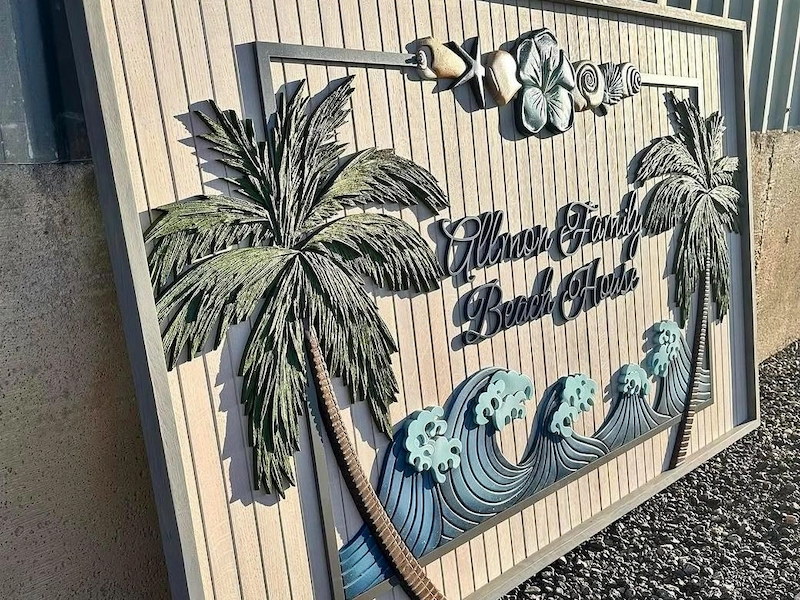
1. How Laser Engraving Machines Work on Wood?
Laser engraving machines use a focused beam of light to etch designs onto wood with incredible precision. The laser generates intense heat, which vaporizes or burns away the surface material in a controlled manner, creating permanent, detailed marks. Unlike traditional engraving methods, which require physical tools, laser engraving offers a non-contact process that produces clean, intricate designs without direct material manipulation.
The process begins when a design is uploaded into the engraving software. As the laser moves across the surface, its intensity and focus are adjusted to suit the specific requirements of the wood type and the design’s complexity. The software ensures that the laser engraver operates at optimal settings for each job, resulting in a high-quality finish.
Depending on the laser project, the laser can perform different types of engraving, from surface etching to deeper cuts. The laser engraver for wood work with various types of wood, including hardwoods, softwoods, and plywood. The result is a smooth, precise engraving with consistent quality.
2. Types of Laser Engraving Machines for Wood
2.1. CO₂ Laser Engravers: Most Common for Wood
CO₂ laser engravers are the most widely used for engraving wood. These lasers use a carbon dioxide gas mixture to generate the laser beam, which is highly effective at cutting and engraving non-metallic laserable materials like wood. They offer excellent precision and can engrave a variety of wood types, including plywood, MDF, and natural woods, making them a versatile choice for both professional and hobbyist woodworkers. Thunder Laser is expert in CO2 lasers, offering high-quality Laser Machine Series for versatile applications.
These lasers can handle a wide range of engraving depths and speeds, depending on the wood’s density and the project’s requirements. Whether you are working on simple designs or intricate artwork, CO₂ lasers provide consistent results, making them the preferred choice for most wood engraving applications.
2.2. Fiber Laser Engravers: Limited Suitability for Wood
Fiber lasers are primarily designed for engraving metals and other hard materials. Although they can technically engrave wood, they are not ideal for most wood engraving applications. Fiber lasers have a much higher frequency and are more focused than CO₂ lasers, making them more effective at marking metals and plastics. When used on wood, fiber lasers tend to produce a rougher finish and can create more heat, which can burn or scorch the material.
They may still be suitable for very specific applications where high-contrast markings or fine details are needed, such as on specially treated or coated woods. However, while fiber lasers are powerful and offer incredible precision, they are typically better suited for applications involving metal or harder materials rather than wood. If you gonna focus on metal rather than non-metallic materials, Thunder Laser Aurora Marker excels in in precision metal marking and carving.
2.3. Diode Lasers: Entry-Level Options for Hobbyists
Diode lasers are a more affordable option for entry-level woodworkers or hobbyists. These lasers operate at lower power levels compared to CO₂, which makes them less effective for cutting thicker wood but still capable of engraving on softer woods. Diode lasers are typically found in smaller, more compact machines, which are ideal for home use or small-scale projects. They are best for light engraving tasks, such as personalizing small items like coasters, keychains, or photo frames.
While diode lasers may not offer the same speed or power as CO₂ lasers, they are still suitable for creating intricate designs on wood. Their relatively low cost and simplicity make them a great entry point for those new to laser engraving, but they may be limited when it comes to larger or more complex wood projects.
3. Applications of Laser Engraver for Wood
Laser engraving and cutting on wood have become essential tools across a wide range of industries due to their precision, versatility, and ability to create intricate designs. Whether for personalization, customization, or production, laser technology has revolutionized the way wood is processed.
Wood laser engraving and cutting are widely used across different industries. In the furniture and home décor industry, laser engraving is used to create unique, customized designs on furniture pieces, wooden panels, and décor items. In the personalized gift industry, laser technology allows businesses to offer custom engravings on a variety of items, such as photo frames, cutting boards, and coasters.
The signage industry utilizes wood laser engraving for creating detailed and durable business signage, nameplates, and directional signs. Similarly, in advertising and marketing, companies use laser-cut wooden elements to craft promotional items, packaging, and branded materials. Arts and craft industry also relies on laser technology to produce intricate wood carvings, sculptures, and other artistic pieces. In the education sector, laser engravers are used for creating custom classroom items, awards, and promotional educational tools.
Some of the most popular products created with wood laser engraving and cutting include custom cutting boards, coasters, photo frames, plaques, and trophies. These products are often personalized with names, messages, logos, or intricate designs, making them perfect for gifts, awards, and promotional giveaways. Additionally, wooden signs, logos, and decorative items such as keychains, jewelry, and small sculptures are highly sought after in both the retail and crafting markets.
Wood laser engraving and cutting offer tremendous potential across a diverse range of industries. With its broad applications and popular product options, laser continues to grow as a preferred method for wood processing and customization.
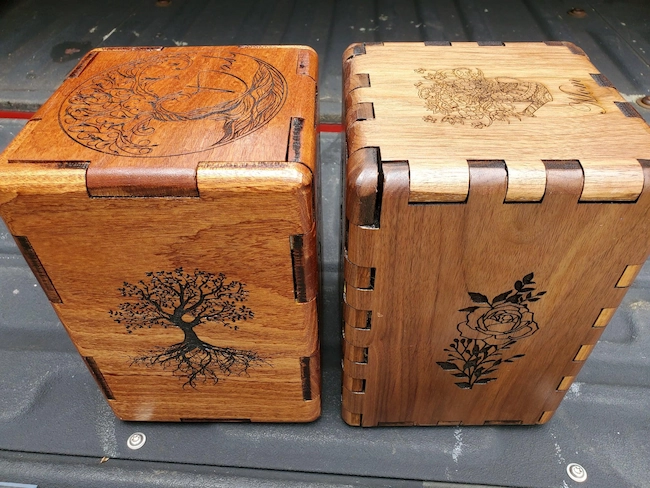
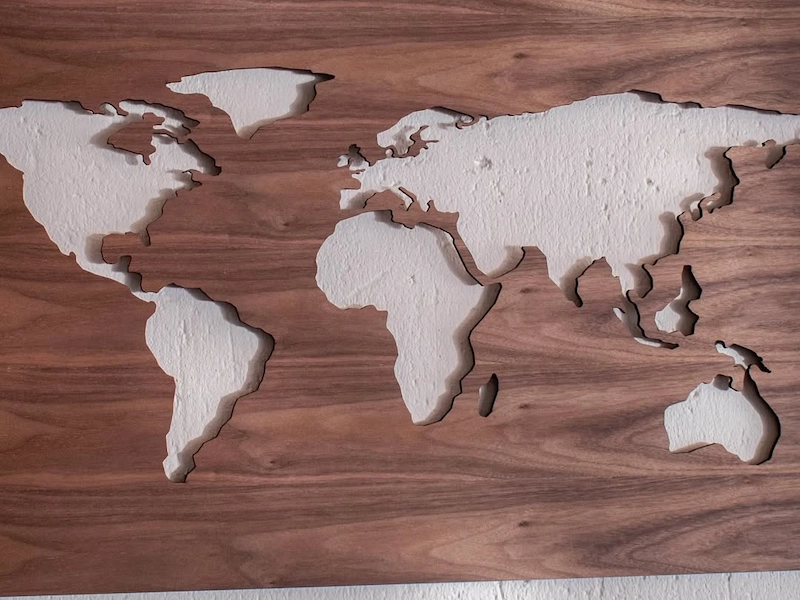
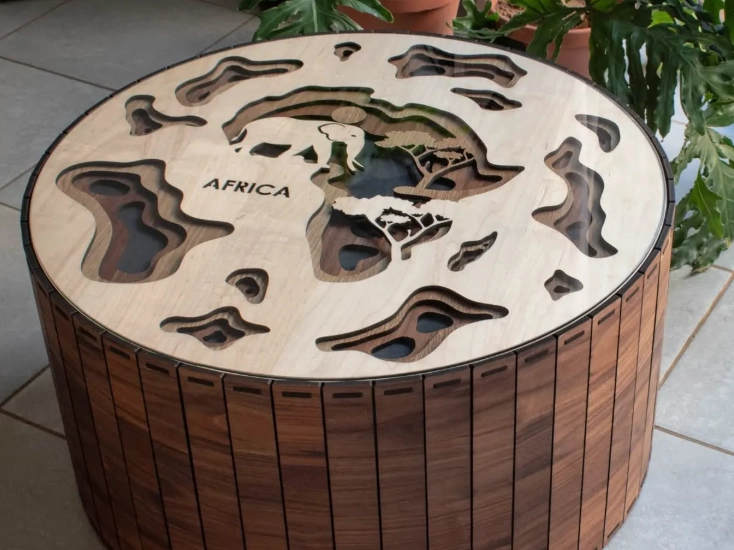

Explore Laser Engraving Ideas and Free Laser Designs in Sample Library
4. Features to Consider in a Laser Engraving Machine for Wood
4.1. Laser Type and Power
4.2. Work Area Size
The size of the work area in a wood laser engraving machine plays a crucial role in determining the scale and complexity of the projects you can undertake. A larger work area allows for larger wood pieces and more complex designs, while a smaller machine may be suitable for smaller, more detailed projects.
For those who need even more flexibility, laser machines like the Nova Laser Cutter and Bolt Laser Engraver come with a pass-through door, offering the ability to engrave on larger materials that wouldn’t normally fit within the standard work area. This feature provides additional space for oversized projects, making it easier to work with longer or bulkier wood pieces.
4.3. Software Compatibility
Most laser engravers are compatible with popular design software such as Adobe Illustrator, CorelDRAW, and LightBurn, which are commonly used by professionals and hobbyists alike. You should make sure your laser engraver for wood can run these software programs, which allow users to create and edit designs with precision before sending them to the laser machine for engraving or cutting.
Designed by Thunder Laser team, LaserMaker is also an intuitive, powerful, and user-friendly design program specifically designed for laser engraving. You can download LaserMaker software from our website. It allows for a quick and easy installation process, and our team provides support for setting up the software with your laser engraver.
4.4. Rotary Attachments
These attachments allow the laser engraver to rotate the material during the engraving or cutting process, making it possible to engrave on items like cups, bottles, pens, and other round or cylindrical objects. For wood projects, rotary attachments allow for engraved designs on cylindrical wooden products like rolling pins, pens, and even decorative wooden bottles.
When choosing a rotary attachment, consider factors such as the maximum diameter and length of objects it can accommodate, as well as the adjustability to fit different sizes of items. Thunder Laser machines are compatible with a variety of rotary attachments designed to handle different shapes and sizes. These attachments are easy to install and set up, making them a valuable addition for users who want to expand their laser engraving capabilities beyond flat wood surfaces.

4.5. Cooling Systems
Laser machines generate significant heat during operation, and without proper cooling, components like the laser tube could overheat, leading to reduced efficiency or even damage.
Most wood laser engravers use either air cooling or water cooling systems. Air-cooled machines are typically more affordable and require less maintenance, making them a good choice for smaller projects or occasional use. However, for more intense and continuous operations, water-cooled systems are often preferred, as they provide superior heat dissipation and allow the laser engraver to operate for longer periods without risk of overheating.
4.6. Ease of Use
A user-friendly machine ensures that you can quickly get started, minimize errors, and increase productivity. With intuitive controls, clear displays, and easy setup, you can focus more on engraving and less on troubleshooting complex systems.
When evaluating ease of use, consider the control panel and maintenance process. User-friendly control panels with intuitive displays that make it easy to adjust settings such as speed, power, and focus. Besides, machines that are easy to clean, calibrate, and maintain will save you valuable time and effort.
4.7. Air Assist and Exhaust Systems
Air Assist and Exhaust Systems are essential features for ensuring clean, precise engravings and maintaining a safe, efficient working environment. The air assist function helps blow away smoke, debris, and heat from the surface, preventing the buildup of residue that could affect engraving quality. It also helps to reduce the chances of flame-ups during cutting, improving both the safety and accuracy.
On the other hand, the exhaust system directs the fumes and smoke away from the workspace, ensuring proper ventilation. This is particularly important when engraving wood, as it generates smoke and particles that can accumulate and impact the performance of the machine.
5. Benefits of Using Laser Engraving Machines for Wood

5.1. High Precision and Intricate Detailing
The non-contact nature of the laser ensures that the material is not physically disturbed during the engraving process, which results in cleaner cuts and finer detailing compared to traditional methods.
Unlike mechanical engraving or hand carving, where operator skill and tool wear can affect precision, laser engraving maintains consistent quality throughout the operation, providing high repeatability and uniformity in intricate designs.
5.2. Speed and Efficiency
Laser engraving machine for wood with an automated nature can engrave or cut detailed designs on wood much faster than manual methods, such as hand carving or saw cutting, which are labor-intensive and time-consuming.
Furthermore, the laser’s ability to complete tasks with less need for post-process adjustments, like sanding or cleaning up rough edges, making it ideal for mass production.
5.3. Consistency in Processing Quality
Once a design is programmed, the laser follows the same exact path and parameters with every pass, ensuring uniform engraving depth, cut width, and detail across multiple pieces. In contrast, traditional methods—such as routing or carving—are subject to variations in pressure, tool wear, and human error, which can lead to inconsistencies.
The precision of laser technology eliminates these variables, making it the preferred choice for batch production and applications requiring high consistency.
5.4. Versatility Across Wood Type and Project
The laser’s adjustable power settings enable it to adapt to different material densities, allowing users to engrave, cut, or etch on a variety of wood surfaces with precision. A laser engraver for wood can seamlessly handle multiple processes, including engraving, cutting, and etching, within a single workflow.
6. Key Factors to Consider When Choosing a Laser Wood Engraver
6.1. Budget
When choosing a laser engraver for wood, your budget plays a key role. While entry-level models, like diode lasers, are more affordable and suitable for small-scale projects, investing more upfront in a higher-end machine, such as a CO₂ laser engraver, offers greater returns in the long run.
With a larger investment, you get enhanced features like increased precision, larger work areas, faster engraving speeds, and the ability to handle more complex tasks. Ultimately, the more you invest, the more you gain in terms of performance and efficiency.
6.2. Project Scale
For smaller, simple designs on wood for hobbyists, a compact machine with a smaller working area may suffice. However, for larger projects or intricate patterns, you’ll need a machine that can handle bigger wood pieces and provide consistent, high-quality engraving.
CO₂ lasers are often preferred for large-scale projects, as they offer a larger work area and the ability to engrave on thicker materials with ease. Laser Engraver with large work area like Thunder Laser Nova supports your mass production during peak seasons, ensuring that you complete your orders on time with high quality.
6.3. Custom Support
A reliable support system can save you valuable time and frustration, especially if you encounter technical issues or need assistance with machine setup. Look for a manufacturer that offers responsive customer service, including accessible technical support, clear documentation, and helpful troubleshooting resources. Additionally, online tutorials, user manuals, and dedicated helplines can ease the learning process, particularly for beginners.
Thunder Laser offers extensive customer support, including step-by-step guides and a responsive support team, ensuring that you have the assistance you need at every stage of using your machine. Having strong customer support gives you peace of mind, knowing that you can rely on expert help whenever necessary.
7. Thunder Laser: Your Best Laser Wood Engraver Choice
Conclusion
Laser engravers for wood offer unmatched precision, speed, and versatility, making them invaluable tools for both amateur and professional woodworkers. Whether you’re engraving intricate designs or creating personalized gifts, choosing the right wood laser engraver can significantly enhance your woodworking projects.
By considering factors such as laser type, power, and machine features, you can select the best laser engraver for wood that suits your needs and budget. Invest in the right machine, and you can watch your woodworking creations come to life with laser engraved perfection.
FAQs about Laser Engraver for Wood
Q1. Can any laser engraving machine work on wood?
Not all laser engravers are suitable for engraving wood. CO₂ laser engravers are the most effective for wood engraving, while fiber lasers are generally not recommended for this material. Diode lasers can also engrave wood, but they are limited in power and precision.
Q2. What is the recommended power for engraving thick wood?
For engraving thick wood, a higher-powered CO₂ laser is recommended, typically between 40W to 150W. The more powerful the laser, the deeper and faster it can engrave thicker wood.
Learn More: Laser Settings for Different Materials
Q3. How long does a laser tube of laser wood engraver last?
The lifespan of a laser tube depends on its power and usage. On average, a CO₂ laser tube can last between 2,000 to 10,000 hours of use before needing to be replaced.
Q4. Do I need special design software for a laser engraver for wood?
Yes, you’ll need compatible design software like LightBurn or LaserGRBL to create and manage engraving files.
Q5. Can a laser engraver for wood engrave on cylindrical wooden objects?
Yes, with a rotary attachment, you can engrave on round items like wooden cups or rods.



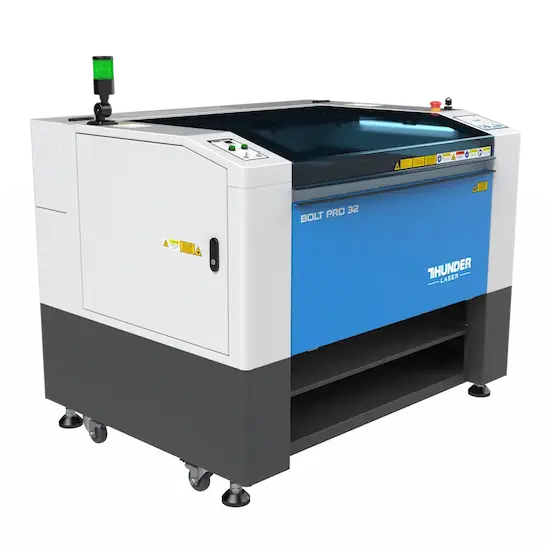

.png) International
International
 United States
United States
 Brasil
Brasil
 Canada
Canada
 Costa Rica
Costa Rica
 Mexico
Mexico
 Česká
Česká
 Romania
Romania
 Polska
Polska
 Ireland
Ireland
 Portugal
Portugal
 Lietuva
Lietuva
 Россия
Россия Deutschland
Deutschland
 Britain
Britain
 Україна
Україна
 France
France
 Sverige
Sverige
 Italia
Italia
 Norway
Norway
 Denmark
Denmark
 Ελλάδα
Ελλάδα
 한국
한국
 中国
中国
 ประเทศไทย
ประเทศไทย
 中国香港
中国香港
 Israel
Israel
 中國臺灣
中國臺灣
 India
India
 پاکستان
پاکستان
 پශ්රී ලංකා
پශ්රී ලංකා
 ジャパン
ジャパン
 Australia
Australia
 New Zealand
New Zealand
 South Africa
South Africa